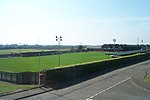Cowdenbeath
BurghsCowdenbeathMining communities in FifePages including recorded pronunciationsPages that use Phonos ... and 3 more
Parishes in FifeTowns in FifeUse British English from June 2015

Cowdenbeath ( ; Scots: Coudenbeith) is a town and burgh in west Fife, Scotland. It is 5 miles (8 km) north-east of Dunfermline and 18 miles (29 km) north of the capital, Edinburgh. The town grew up around the extensive coalfields of the area and became a police burgh in 1890. According to a 2008 estimate, the town has a population of 14,081. The wider civil parish of Beith has a population of 17,351 (in 2011).
Excerpt from the Wikipedia article Cowdenbeath (License: CC BY-SA 3.0, Authors, Images).Cowdenbeath
Stenhouse Street,
Geographical coordinates (GPS) Address Nearby Places Show on map
Geographical coordinates (GPS)
| Latitude | Longitude |
|---|---|
| N 56.11 ° | E -3.35 ° |
Address
Cowdenbeath Clinic
Stenhouse Street
KY4 9DA
Scotland, United Kingdom
Open on Google Maps








